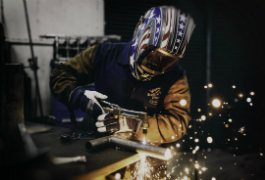Spotlights
Structural Iron and Steel Workers, Fitter, Iron Worker, Ironworker, Steel Fabricator, Steel Worker, Structural Steel Erector, Tower Hand
Ironworkers install iron or steel beams, girders, and columns to form buildings, bridges, and other structures.
- A sense of accomplishment when you finish a project
- Autonomy: You can work as much and as little as you want.
- Typically you start at 6:30am-3:30pm: Able to do other projects in the afternoon.
- Work with your hands!: “When you are mechanically inclined, the trades are excellent for that.”
- Travel: If you are an international ironworker, you could do a job in another country if you want to. When you are young before you have a family and want to travel, you can work in different states and even different countries.
Ironworkers are “industrial athletes”, one of the most physical and mental jobs in the skilled trades industry.
Structural
- Unloads, erects, and connects fabricated iron beams to form the project skeleton.
- Works primarily on industrial, commercial and large residential buildings.
- Builds towers, bridges, stadiums, and prefabricated metal buildings
- Erects and installs pre-cast beams, columns and panels.
Reinforcing
- Fabricates and places steel bars (rebar) in concrete forms to reinforce structures.
- Places rebar on appropriate supports and tie them together with tie wire.
- Installs post-tensioning tendons (cables) to place in concrete forms along reinforcing steel.
- Stresses the tendons using hydraulic jacks and pumps after the concrete is poured and hardened
Ornamental
- Installs metal windows into buildings a building's masonry or wooden openings.
- Erects curtain wall and window wall systems that cover the steel or reinforced concrete structure of a building.
- Installs and erects metal stairways, catwalks, gratings, doors, railings, fencing, elevator fronts and building entrances.
Rigging and Machinery Moving
- Loads, unloads, moves and sets machinery, structural steel and curtain walls.
- Operates power hoists, cranes, derricks, forklifts and aerial lifts.
- Has knowledge of fiber line, wire rope, hoisting equipment and proper hand signals.
Welding and Burning
Welding and burning equipment are considered tools of the trade and performed by structural, reinforcing, ornamental and rigging ironworkers to secure their work to the structure. Ironworkers can be tested to be designated a certified welder.
- Manual dexterity: good with your hands.
- Hand eye coordination
- Critical thinking and problem-solving: will encounter unexpected problems and you will have to figure them out in a timely fashion.
- Attention to detail
- Physical strength and stamina
- Balance
- Unafraid of heights
- Foundation, structure and building exterior contractor
- Heavy and civil engineering contractor
- Union negotiates competitive rates: For example) In Forest Park, IL, $40.82 per hour as journeyman which is the position after you are an apprentice.
- Full medical benefits (medical, dental, vision)
- Pension
- Annuity
- Access to better jobs and amazing opportunities
- Dangerous: Have higher-than-average risk of injury and illness. Workers may experience cuts from sharp metal edges and equipment, as well as muscle strains and other injuries from moving and guiding structural steel.
- Welding: Getting welding certification is the toughest part of being an ironworker. Takes a lot of practice.
- Downtime: When there isn’t work, you might be laid off and wait for another job. Don’t expect this to be a career where you are working the whole year. Your hourly rate is higher than most and your work is more physically demanding so you don’t need to work every day of the year to make a good living.
- Those who are certified in welding and rigging should have the best job opportunities.
- Those with prior military service are also viewed favorably during initial hiring.
- Building and fixing things! : working with your hands.
- Being outside in nature.
- Sports
- Anything mechanical: Working on cars
Welders are an important part of the industry as they use different welding processes to join two pieces of metal together. That way, they are able to create bridges, structures, small appliances, and more.
Welding doesn’t have to be a male-orientated occupation as there are many women welders that are doing a much better job than men. The welding industry currently employs about 1% of females in its welding force. But it has been able to add more than 1,200 workers in the past three years, which is a lot as opposed to the years prior.
Predictions say that by the year 2024, more than 400,000 experienced welders will retire, leaving the door for women welders wide open.
Becoming a welder is a lucrative job opportunity because it doesn’t only offer you a steady job and a chance to travel all over the world, it also sets you up for life with a very lucrative salary. Reports indicate that a median salary for an Industrial Pipeline Welder starts at $36,000 a year, while a Certified Welding Inspector can earn up to $70,000 on a yearly basis.
Women welders usually feel a great sense of accomplishment for succeeding in a primarily male-orientated field and being a role model for women and young girls that are attracted to trades.
- A high school diploma/GED may be needed, but there are no formal educational requirements
- Ironworkers learn their trade as supervised apprentices over a period of up to 3 or 4 years (~144 hours of technical education plus 2,000 of paid OJT)
- A sample curriculum includes courses in:
- OSHA 10, 30, and Sub part R
- First Aid / CPR / AED
- ForkLift Training
- Scaffold Erector Dismantler
- Trained Fire Watch
- Ironworkers International Qualified Rigger / Crane Signaler
- Architectural Ornamental
- Blueprint Reading
- C.O.M.E.T. - Construction Organizing Membership Education Training
- Foreman Training
- Layout Instrumentation
- Reinforcing Concrete
- Rigging and Cranes
- Structural Steel Erection
- Welding
- Apprenticeships are a time-honored way of learning by doing. Most are sponsored by union and contractor associations (see our Recommended Resources > Websites for details)
- Technical instruction covers proper tool and equipment usage, installation techniques, safety, first aid, blueprint reading, and general construction
- Occupational Safety and Health Administration safety training is also required
- Optional certification programs include:
- American Welding Society welding certifications
- National Commission for the Certification of Crane Operators - Rigger Level I and II
- National Center for Construction Education and Research - Rigger & Signal Person Certification
- International Code Council - Structural Welding Special Inspector; Structural Steel and Bolting Special Inspector
Unions and contractors sponsor apprenticeship programs. The basic qualifications to enter an apprenticeship program are as follows:
- Minimum age of 18
- Driver’s license
- High school diploma or equivalent (GED or take an aptitude test)
- Physically able to do the work
- Pass substance abuse screening
Click here for a list of programs.
- Take courses in high school such as shop, welding, and math
- Start an exercise routine to build strength, stamina, and balance so you can work safely
- Working with iron, sometimes at elevated heights in outdoor conditions, can be very dangerous! Get in the habit of practicing outstanding safety at all times
- Learn how to use and wear proper personal protective equipment
- Obtain your driver’s license so you can make it to job sites on time
- Learn as much as you can on your own about Ironwork. Study books, articles, and video tutorials related to the glass installation
- Volunteer for projects to gain hands-on practical experience
- Get certified in a specialized area to bolster your credentials

- Take pre-apprenticeship classes (gladiator classes) and contractors will come down and watch the people work and start drawing them from that group (like “tryouts”). Doing well in pre-apprenticeship classes almost guarantees you into the apprenticeship program.
- Finish the apprenticeship program (note: you are working with pay while you are an apprentice)
- Union will give you the signatory list: local union will give you some leads, you start making calls to contractors on the list.
- Contact Job Corps
- Ask the local union for help: Get on the “out of work” list.
- Apprenticeships are the best way to get started
Check out sites like Apprenticeship.gov, CareerOneStop, Department of Labor Employment and Training Administration, and Helmets to Hardhats for info on opportunities - If taking classes at a trade or vocational school, ask their career center for assistance
- If you served in the military, check out CareerOneStop or state websites for details on unique Veteran opportunities
- Let potential employers know you plan to stick through the long apprenticeship process
- Estimator: Budgets the job then bids on the job.
- Project Manager: Behind the scenes, paperwork. Make sure request for information is filled out. Money is getting paid. Work in conjunction with Superintendent.
- Superintendent: Takes care of the manpower needs on a jobsite. Materials and workers.
- Foreman: Takes care of the job.
- Lead person: Right hand man of the foreman.
- Personally motivated to learn skills and master the trade
- “They leave it all on the job site.”
- Physically and mentally sharp
- Good with people
- Dedication
- Person who is best with tools and the union elevates these people.
- Leader/Teacher: someone who knows the craft so well and they teach others.
Websites
- American Welding Society
- Apprenticeship.gov
- Associated Builders and Contractors
- Associated General Contractors of America
- CareerOneStop
- Department of Labor Employment and Training Administration
- Helmets to Hardhats
- International Association of Bridge, Structural, Ornamental and Reinforcing Iron Workers
- National Center for Construction Education and Research
- National Commission for the Certification of Crane Operators
Books
Alternate careers: Boilermakers, Carpenters, Welders
"The most helpful thing to say to someone thinking of being an ironworker is just to try it out. If anyone feels any proclivity to such work they should give it a go.
After some short time, they will know if that is a career for them or not. People that love working with metal will fall in love with it as soon as they spend some time in a shop or on site. On top of that is to never stop improving and finding more ways to love your work. This is a tough profession and after many years of day in and day out work you will eventually wear out. The secret is to constantly be trying new things and branching out. If you weld MIG for many years then you could start learning TIG which is a very different game. If you are working in fabrication for too long and it becomes monotonous then you could try construction. That way you learn new things, meet new people, exchange experiences and forge your own path that may lead you to who knows where but wherever it does, it will be a place where only those with experience and love for their work can get to." Adam Mason, Welding Pros
Newsfeed

Featured Jobs

Online Courses and Tools









